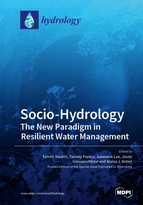Socio-Hydrology: The New Paradigm in Resilient Water Management
A special issue of Hydrology (ISSN 2306-5338). This special issue belongs to the section "Hydrology and Economics/Human Health".
Deadline for manuscript submissions: closed (30 June 2021) | Viewed by 35469
Special Issue Editors
2. College of Agriculture, Urban Sustainability and Environmental Sciences (CAUSES), University of the District of Columbia, Washington, DC 20008, USA
Interests: climate change and water resources; food, energy, water nexus; watershed science
Special Issues, Collections and Topics in MDPI journals
Interests: urban agriculture; geospatial technology education and outreach K-16
Interests: water infrastructure analytics; water distribution; building water systems
Special Issues, Collections and Topics in MDPI journals
Interests: climate variability vs. climate change; flood susceptibility; green infrastructure; stormwater & energy conservation
Interests: TMDL planning and implementation; sustainable water management
Special Issues, Collections and Topics in MDPI journals
Special Issue Information
Dear Colleagues,
Socio-hydrology is a new interdisciplinary field that aims to study the long-term dynamics of bidirectional feedback in coupled human-water systems. The science of coupled human-water systems indicates that global biophysical and social processes are strongly interconnected. Hydrologic systems are significantly influenced by anthropogenic factors such as land use (urbanization, deforestation and agriculture); water use and water infrastructure; and other human activities. Additionally, changes in hydrologic systems caused by anthropogenic factors significantly impact global ecosystems, socio-economics, and climate change. Socio-hydrologic study is a paradigm shift toward examining tradeoffs and synergies in coupled human-water systems to provide scientific feedback for defining resilient solutions that resolve complex water management problems. The feedback approach in socio-hydrologic studies enhances the concept of Integrated Water Resources Management (IWRM), a practice that promotes the coordinated development and management of water, land and related resources in order to maximize economic and social welfare.
In recent decades, the strong interconnectedness of the global economy has significantly increased the importance of global climate variability, hydrologic conditions and human activities as critical factors in sustainable management of water resources. There is a significant need to understand the nature of hydrological systems and anthropogenic factors contributing to the dynamics and resilience of coupled human-water systems and effective risk management in the arena of water management. This need has also led to developing socio-hydrologic models at various scales for sustainable management of water resources, locally, regionally, nationally, and globally.
This Special Issue on socio-hydrology intends to compile interdisciplinary (natural & social sciences) scientific endeavors and innovations on coupled human-water systems research development, applications and challenges. Research articles are solicited including, but not limited to the following topics: (1) methods of scientific inquiry for socio-hydrology; (2) learning about coupled human-water systems from an historic perspective; (3) comparative socio-hydrologic studies across interdisciplinary boundaries; (4) analysis of spatial dimension of socio-hydrologic factors; (5) resilience assessment and risk management in coupled human-water systems; (6) socio-hydrologic modeling techniques and applications; (7) challenges and opportunities in socio-hydrology learned from research and case studies; and (8) other topics relevant to the Special Issue theme.
Dr. Tamim Younos
Dr. Tammy Parece
Dr. Juneseok Lee
Dr. Jason Giovannettone
Alaina J. Armel
Guest Editor
Manuscript Submission Information
Manuscripts should be submitted online at www.mdpi.com by registering and logging in to this website. Once you are registered, click here to go to the submission form. Manuscripts can be submitted until the deadline. All submissions that pass pre-check are peer-reviewed. Accepted papers will be published continuously in the journal (as soon as accepted) and will be listed together on the special issue website. Research articles, review articles as well as short communications are invited. For planned papers, a title and short abstract (about 100 words) can be sent to the Editorial Office for announcement on this website.
Submitted manuscripts should not have been published previously, nor be under consideration for publication elsewhere (except conference proceedings papers). All manuscripts are thoroughly refereed through a single-blind peer-review process. A guide for authors and other relevant information for submission of manuscripts is available on the Instructions for Authors page. Hydrology is an international peer-reviewed open access monthly journal published by MDPI.
Please visit the Instructions for Authors page before submitting a manuscript. The Article Processing Charge (APC) for publication in this open access journal is 1800 CHF (Swiss Francs). Submitted papers should be well formatted and use good English. Authors may use MDPI's English editing service prior to publication or during author revisions.
Keywords
- Coupled human-water systems
- sustainable water management
- climate variability
- hydrologic influences
- anthropogenic factors
- human behavior
- socio-economic factors
- resilience
- risk management
- IWRM








